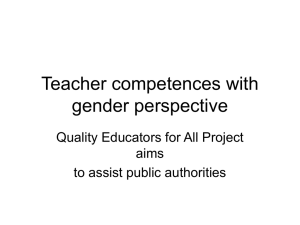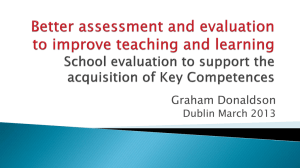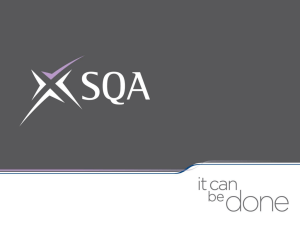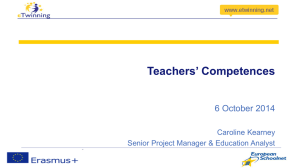Kuwait National Curriculum - Alassemah ELT Supervision Official
advertisement
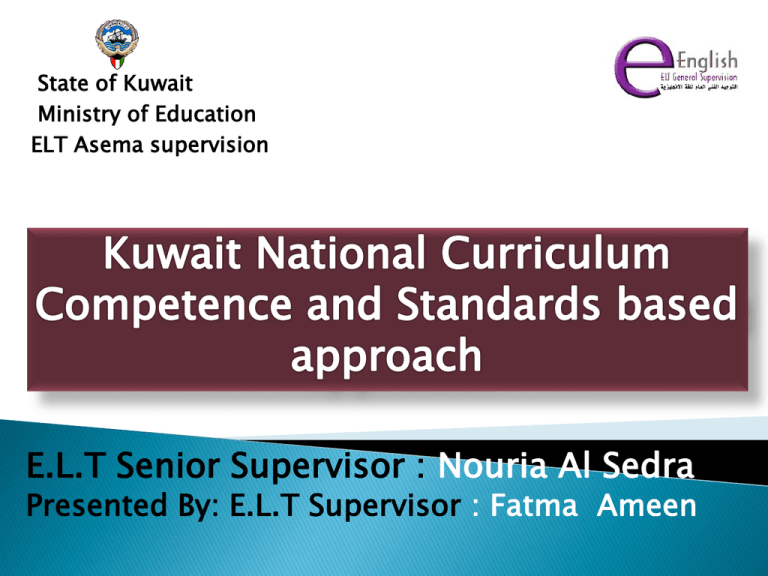
State of Kuwait Ministry of Education ELT Asema supervision E.L.T Senior Supervisor : Nouria Al Sedra Presented By: E.L.T Supervisor : Fatma Ameen Project Presentation: Curriculum and Standards Component School Education Quality Improvement (SEQI) Partnership Program between the Government of the State of Kuwait and the World Bank Group SEQI Project has three main components: 1. Curriculum and standards for grades 1 to 12. 2. National Education Standards for Teachers, School Leadership and Students . 3. National Assessments (MESA). II. Short overview of the process: phases Preparing human resources Preparing National conceptual Curriculum Documents Preparing National operational Curriculum Documents Preparing subject curricula and standards Preparing the implementation Process How do we exercise these competences ? An initial cascade training model has been designed where each cascade trains the following one: International consultants Master trainers School principals Subject trainers Teachers Head teachers At the end of the session you will be able to: Explain the reasons for a new curriculum approach in Kuwait Primary Education. Describe the concept of competence-based curriculum as a process. List the main components of the Kuwait National Curriculum. Explain the main terminology related to competence- and student achievement standards-based approach A GOOD CURRICULUM CAN CHANGE THE FACE AND FATE OF A NATION Why a new Curriculum in Kuwait? National Challenges New vision of Kuwait as expected by his Highness Sheikh Sabah Al-Ahmad Al-Jaber Al-Sabah, Amir of the State of Kuwait New social, economic, political, cultural and human challenges New learning needs and expectations of children and youngsters towards school International challenges Globalization Knowledge Economy The Digital Age (CPD )Continuous Development . Learning to Live Together Lifelong learning What are the skills of the 21st century? Why 21st century skills learning? How is Teaching in the 21st century ? Being Creative and Innovative Undertaking critical thinking, problem solving and decision making Illustrating metacognition, learning to learn and original/meaningful thought. Ways of Thinking Citizenship – local and global; 21st Century Skills Ways of Working Communication capabilities. Collaborative capabilities. Living in the World. Life and Career capabilities and values; Information and ICT literacy (learning in digital networks) Capability to undertake Personal and Social responsibility. To develop a quality curriculum and standards, you should have a common understanding regarding the following questions (concepts). Concepts to be approached Curriculum Standards Kuwait National Curriculum Kuwait National Curriculum Framework Specific competenceS Competencebased curriculum General competenceS KeycompetenceS CompetenceS The Word : Curriculum Latin: The term, ‘curriculum’ is derived from the Latin word "Currere" which means to run/to proceed. Currere refers to the ‘course of deeds and experiences through which children grow to become mature adults.’ a) b) c) What outcomes do we want? What content is therefore needed? How can that best be taught/learned? How do we best assess that? How do we evaluate our process? Cronbleth (1992) defines curriculum as answering three questions: What knowledge, skills and values are most worthwhile? Why are they most worthwhile? How should the young acquire them? A curriculum is a system of learning experiences and opportunities that are planned for children and young people through their education. ◦ A curriculum represents a multifunctional, but highly organized system of knowledge, skills and attitudes/values that all individuals are offered by a given education system (and society) and that is useful for personal fulfillment and development, inclusion and employment in a well-functioning society. Curriculum is the reality of learning in /outside the classroom which is not shown in books and documents False assumption- Curriculum is the textbook! Difference Between A Syllabus & A Curriculum (Task) Syllabus Curriculum Difference Between Syllabus & Curriculum Syllabus Functionally a “Syllabus” is generally a uni-dimensional document. It merely presents the content or the subject matter to be studied. Curriculum A curriculum is three dimensional , because it takes into account: the needs of the students, the content of different subjects and instructional methodology What do you think? Please discuss in group Each group is kindly asked to give a set of answers Inclusiveness. First, assisting every student, regardless of ability, gender or social circumstances, to reach their individual potential as learners. Each student is different. Not all are academically gifted. But all students can be encouraged to do their best development in helping them achieve their potential. Future-orientation. Secondly , the curriculum will be forward-looking and prepare learners for the future through the development of broad competencies. The curriculum will need to develop student competency in Communication, Collaboration , Critical thinking , problem solving, and Creativity . Differentiation. Thirdly, the curriculum will permit curriculum differentiation, it will provide space for teachers to adapt the curriculum to suit the students in their classes. It will not demand that every student learn exactly the same content in exactly the same way and in exactly the same number of hours. New teacher roles. Finally, the curriculum will promote a new role for the teacher, a new individualized teacher-student relationship and a desire in teachers to encourage inquiry and curiosity. Similarly, the teacher in the role of assessor should use assessment not just to test how well content is learned, but to understand the strengths and weaknesses of individuals. The curriculum offers not only the WHAT but also the Why? When? How? In which concrete context? With which expected results? Connected to what? Kuwait National Curriculum covers the overall system of learning experiences offered to children and students of Kuwait in all ordered subjects in terms of knowledge, skills and attitudes/values from ages 3 to 18 by relevant educational institutions. Therefore, the National Curriculum defines, by necessity, what students should know, be able to do, and how they should behave in terms of valuesoriented human beings as a result of their learning process. KNCF •Standards •Rationale •Competences •Conceptual foundations •Teaching plan •Vision •T/L Resourses •Mission •philosophy •Principles "Curriculum Framework" The Story Of Learning processes products prospects The KNCF is the main conceptual document that regulates the Kuwait curriculum system. The KNCF has a normative, prescriptive and regulatory role. It presents the conceptual foundation, the vision, the philosophy, as well as the concrete ways in which learning is organized and offered to children and students of Kuwait throughout various education stages, from grades 1 to 12. The Kuwait National Curriculum Framework indicates: The rationale of the new Kuwait National Curriculum The conceptual foundations of the new curriculum The key curriculum statements; the vision, the philosophy, principles and the mission of the curriculum system in Kuwait. The types of competences student should acquire through schooling. The type of standards that describe the level of achievement of the competences at different stages of schooling The way in which the curriculum is organized in a Teaching Plan and in this context in a number of subject matters. The Kuwait National Curriculum Framework clearly guides policy makers, curriculum writers, schools and education administrators in the process of designing, organizing, managing and assessing school activities and their effectiveness key curriculum statements Vision Mission Philosophy principles Task Discuss in groups the meaning of each word and why they are essential in building any curriculum. Understanding the key curriculum statements The Curriculum Statements have the role of regulating the whole curriculum system, including the subject curricula and standards. They concretely determine - what, why and how, based on what rationale, in which order and – last but not least – with what kind of benefits for learning do children and students in Kuwait get within their education. The basic Curriculum Statements are: Vision Mission Philosophy principles The future citizens should be: Confident in their Islamic, national and global identity Actively involved in social and individual growth Connected to other people and the environment Lifelong learners In the light of the Kuwaiti Vision for its future, the Mission of the new Kuwait National Curriculum is to contribute to the education of a new generation fully equipped with the key competences needed for making the country a financial and commercial power in the current world. On the grounds of preserving Islamic, Arabic and National Kuwait values, in the next twenty – thirty years, we should educate citizens who cherish and respect their country, their traditions and their national identity, being at the same time open to acquiring multiple identities as citizens of Kuwait, the Gulf, the larger Arab World, and the World at large. The following key Educational and Curriculum Philosophies of the 21st Century are seen as playing a leading role: Developing a holistic, complex personality, equipped with a genuine respect for Islamic, National and general human values and fully committed to personal development. Enhancing Education for All and Inclusiveness as key pillars of the National Curriculum. Consistently infusing the life-long learning perspective as well as the pre-eminence of learning processes as compared to the teaching processes. Fully assuming the Philosophy of Globalization, the Knowledge and Learning Economy, the Digital Age and Sustainable Development, while educating students to preserve national values and traditions. Promoting the real integration of the domains of knowledge as one of the most important current trends in curriculum development and in teaching and learning internationally. The Kuwait National Curriculum is developed based on a set of principles and criteria aimed at ensuring coherence at the level of its design and development and – at a later stage – of its implementation. These principles, related to different aspects of the National Curriculum, are concise statements that express the characteristics of the new curriculum approach or education improvement in Kuwait A. Principles related to Curriculum as an overall System B. Principles related to the Learning Process C. Principles related to the Teaching Process D. Principles related to the Assessment of Students’ Achievements Kuwait National Curriculum is based on the competences children and students aged 3 to 18 are supposed to acquire and the learning achievement standards that indicate to what extent this process effectively happens over the school years and/or at different stages of the process. What is a competence- and standard-based curriculum? A curriculum that emphasizes what the learners are expected to do rather than mainly focusing on what they are expected to learn about. In principle such a curriculum is: Learner-centered and adaptive to the changing needs of students, teachers and society, and Real life needs-centered: implying that learning activities and environments are chosen so that learners can acquire and apply the knowledge, skills and attitudes to situations they encounter in everyday life. In a competence-based curriculum, the aims of education are achieved by gradually developing a coherent system of key, general and specific competences that are measurable by means of the learning achievement standards and their detailed indicators. The main idea of competencybased curriculum illustrates: 1.Instead of objectives, think “competences” 2.Instead of content, think outcomes 3.Learner activities will be based on performance of learners. 4.Teaching activities are learner centered 5.Formative evaluation is necessary The main idea of competency-based education Competences are integrated systems of knowledge, skills, attitudes, values and beliefs developed through formal (and non-formal) education that allow individuals to become responsible and autonomous persons, able to solve a diversity of problems and perform in everyday life-settings at the quality level expressed by the standards. What are the Competences? The Kuwait National Curriculum operates with three types of competences Key competences General competences Specific competences What are the Key Competences? key competences(NON-SUBJECT )specific represent a transferable, multifunctional package (system) of knowledge, skills, values, attitudes, beliefs, and personal/social attributes that all individuals need to acquire for their personal development, inclusion and employment (i.e. for being successful in their personal and social life, as well as in their professional career). key competences are supposed to be achieved by the end of the Secondary Education period. They are crosscurricular (i.e. non-subject specific), transferable and multifunctional competences – so that, in principle, all subjects can/should contribute to their development. The Key Competences students should master by the end of Grade 12 are: 1. 2. 3. 4. 5. 6. 7. 8. Islamic Religious and Ethical Competences Communicative Competences in Arabic Language Communicative Competences in English and other Foreign Languages Mathematical Competences Social and Civic Competences Scientific, Technological and Digital Competences Personal Development and Learning to Learn Competences Life and Work, Economic and Financial Competences As compared to the key competences General competences are subject-specific. They define the most general subject-based knowledge, skills and attitudes/values embedded/integrated in students’ expected outcomes by the end of Grade 12. General competencies developed through the study of English Listening to oral messages by means of different strategies in a variety of contexts for effective comprehension Speaking by using strategies of individual and interactive speech in a variety of communicative contexts Reading and viewing a range of texts by means of different strategies in a variety of contexts Writing a range of texts adapted to a variety of communicative purposes www.themegallery.com Specific Competences The specific competences are structured and developed in students during a school year. As compared to the General Competences: Specific Competences define more specific systems of integrated knowledge, skills and attitudes/values. They can even cover specialized, topic-based competences students are supposed to display by the end of each grade. The specific competences are clustered in the following four dimensions: A range of realities specific to the subject (knowledge); A range of operations (skills and strategies) A range of personal and social responses (attitudes, values) A range of connections with other subjects and domains. 2. Speaking by using strategies of individual and interactive speech in a variety of communicative contexts A range of language realities 2.1. Using simple words, expressions and sentences to express themselves about self, family, food and other items in small conversations or individual speech A range of operations 2.2. Responding to simple communicative situations in mini dialogues related to everyday topics A range of attitudes 2.3. Building up positive personal motivation to speak with peers and adults using simple phrases and sentences A range of connections 2.4.Using the knowledge and abilities acquired in other subjects when producing sounds of English or speaking about their family or school www.themegallery.com Group Work Task What do you think are the differences between competences and learning objectives ? The difference between competences and learning objectives Competences define the applied skills , attitudes and knowledge that enable people to successfully perform their work Competences are relevant to an individual’s job responsibilities, roles and capabilities. They are a way to verify that a learner has in fact learned what was intended in the learning objectives. learning objectives are specific to a course of instruction. Learning objectives describe what the learner should be able to achieve at the end of a learning period. Learning objectives should be specific, measurable statements and written in behavioral terms. The difference between competences and learning objectives Competences say how we can be certain they know it. Objectives say what we want the learners to know Here is an example of competencies and learning objectives relating to the competency: Competency: Utilizes appropriate methods for interacting sensitively, effectively, and professionally with persons from diverse cultural, educational, and professional backgrounds, and persons of all ages and lifestyle preferences. Learning objectives from a course that relate to the above competency Describe the demographic trends related to diverse populations in the United States and abroad Compare and contrast diversity and cultural competency in the public health context Identify a framework to design culturally competent public health care services for diverse populations What are Standards? All competence-based curricula – including the new Kuwait National Curriculum – introduce and largely use the concept of standards. Standards Standards are statements about what is valued IN LEARNING. They describe expectations and are used to judge the level of performance in a field or domain. An operational decision, requirement or regulation related to the quality level to be achieved by a certain aspect of the education system”, (in our case, student’s learning) Standards are the WHAT of education while curriculum and instruction are the HOW.” What types of standards in KNC? Performance Standards Curriculum standards They refer to the quality level to be achieved by students’ in performing their general competences by the end of each of the school stages – i.e. Primary, Intermediary, and Secondary. The measurement of the performance standards is a matter of different forms of national summative assessments or examinations. Measurement Process By the end of grade 9 By the end of grade 5 By the end of grade 12 Performance standards for MESA They refer to the quality level to be achieved by students in attaining the specific competences. Curriculum standards describe to what extent the specific competences should be achieved by the end of each grade. In the Kuwait Curriculum, curriculum standards are related to specific competences defined in the subject curriculum. Curriculum standards are a matter of school- and class-based formative and summative assessment. Measurement Process By the end of each grade curriculum standards for school exams Key Competencies To be achieved by the end of grade 12- cross curricular General Competencies To be achieved by the end of grade 12 subject specific Specific Competencies To be achieved by the end of each grade Performance standards Level of achievement by the end of each stage 5,9,12 Curriculum standards Level of achievement by the end of each grade What is Subject Curricula? Are official documents that define why, what, how and with which kind of final expected results students learn in a certain subject from Grades 1 to 12. They fully reflect the conceptual foundation and the provision of the key curriculum statements as defined by the Kuwait National Curriculum Framework. Why Subject Curricula and Standards are important? Subject Curricula and Standards are an essential part of the curriculum for all those interested in education: students, parents, teachers, school principals, supervisors and curriculum and standards developers, Education. They offer a clear vision for the knowledge, skills and attitudes/values to be achieved by a student by means of the concrete learning process (textbooks included). Well-structured curricula generate efficient teaching learning materials as well as a learning process that inspires extends and motivates students for achieving the competences and the standards mentioned in the curriculum. Task Curriculum Concepts New curricula Moving from To 1.Content /skill/ based curriculum Competency and standard based 2. Knowledge / skills /performance focus Skills/performance focus 3. Teacher’s/student Student’s centered class centered ( PPP) class ( PPP ) 4. Summative / evaluation Formative & summative evaluation ) Ps and teachers) Moving from To 5.Parents are not much involved and are not aware of standards Parents are involved and know the standards 6. Cognitive Domain 7.Proficiency Domain A range of language realities A range of operations 8. Affective domain A Range of attitudes 9. Transfer Domain Integration of school subjects A range of connection 10.Progression of skills from one Progression of skills is clearer , grade to another was not among organized , and a good guide for teachers priorities teachers 11.Ambitious,hard to achieve standards/objectives Activities designed made standards more applicable Roughly: - - - To plan the teaching-learning-assessment process within a larger period of time To choose/produce and use a wide range of TLM that represents best the curricular content and helps to achieve the performance standards To choose and use interactive methods of teaching on a daily basis To adapt the teaching style, methodology and TLM to every classroom needs To use creatively all the assessment methods and tools To systematically study the innovations in the relevant area of science To focus the learning process on competence gain (instead of memorizing the information) To constantly work at self-improvement, to be methodologically creative To acquire educational skills by involving in various CPD activities To demonstrate openness, collaborating with other teachers of different subjects, school management and community Considering the requirements, they should: - Be automatically involved in CPD programs to foster their teaching competencies in order to operate with the new curriculum - Be encouraged and supported by the supervisors and school principals to apply the new curriculum at classroom level - Have time to reflect on the new procedures with other people - Have the guidance of their Head Teacher and access to examples of best practices in subject teaching - Be active participants in their own CPD Be motivated, promoted for the outstanding work reflected in the students’ achievements -
